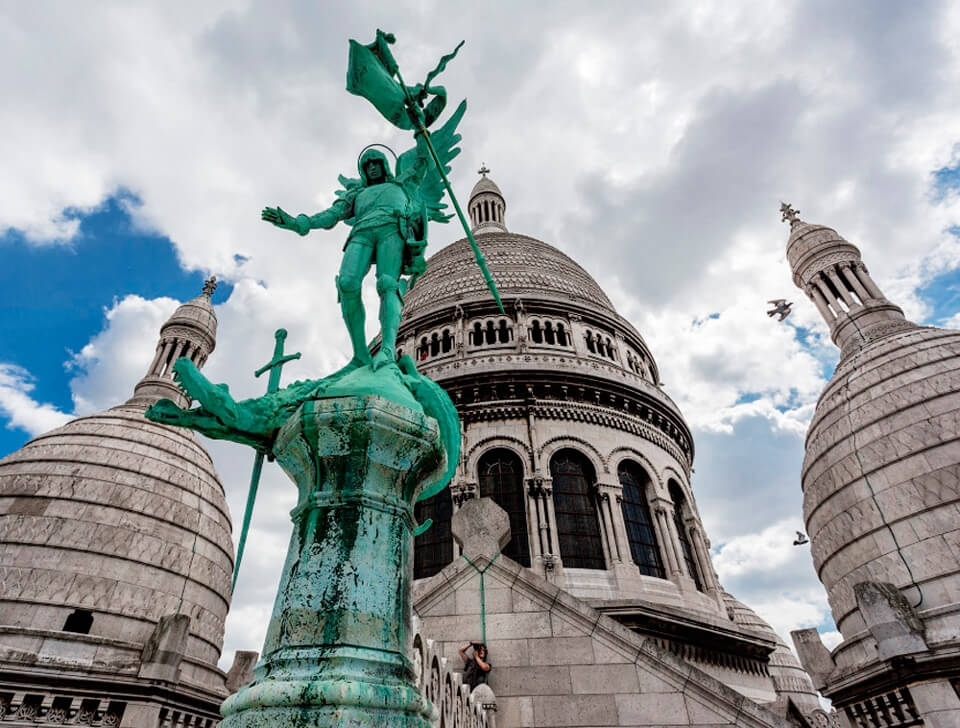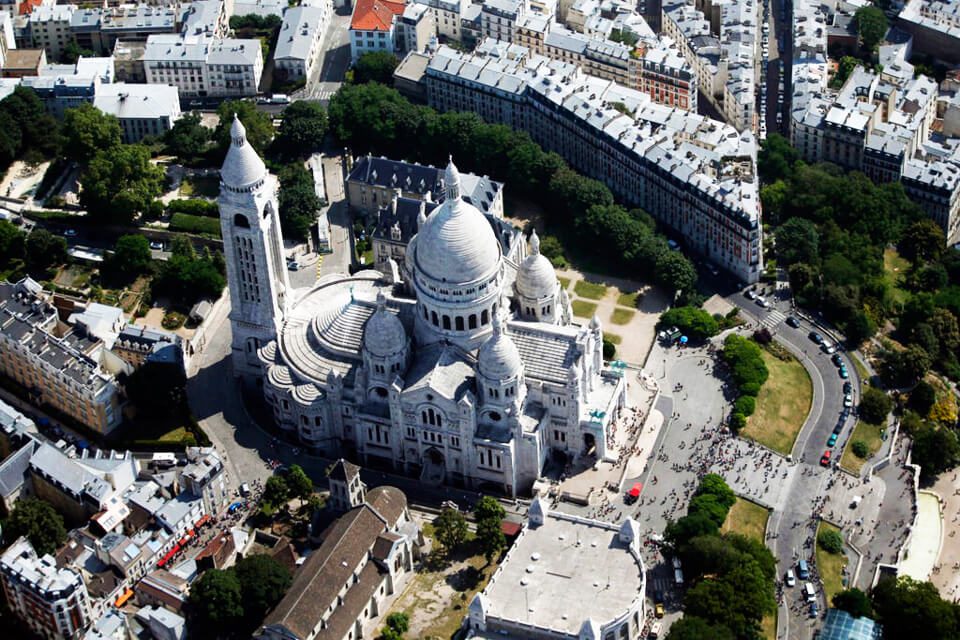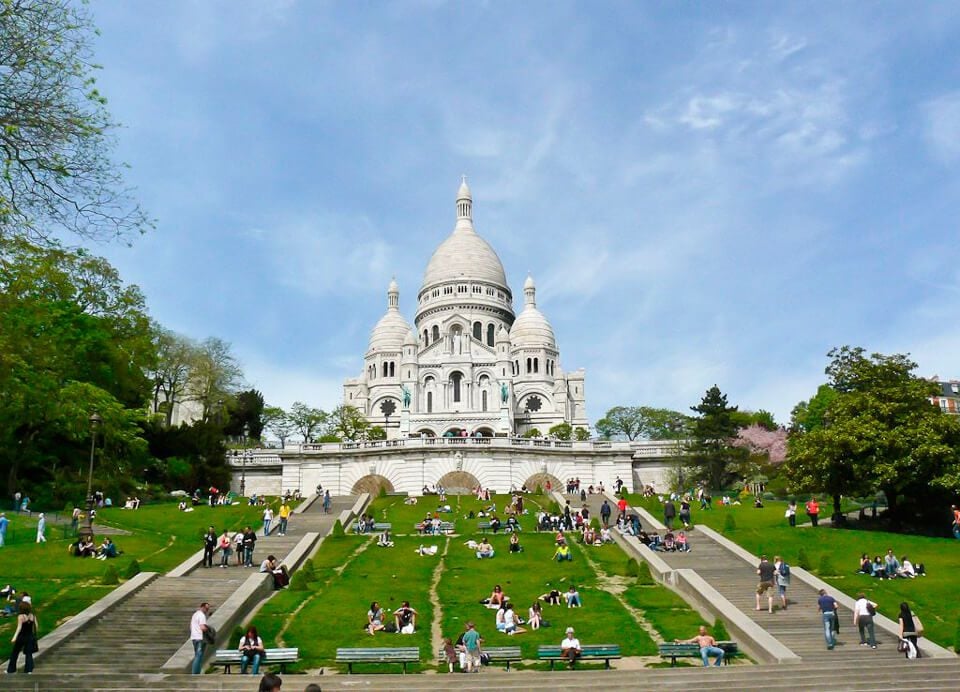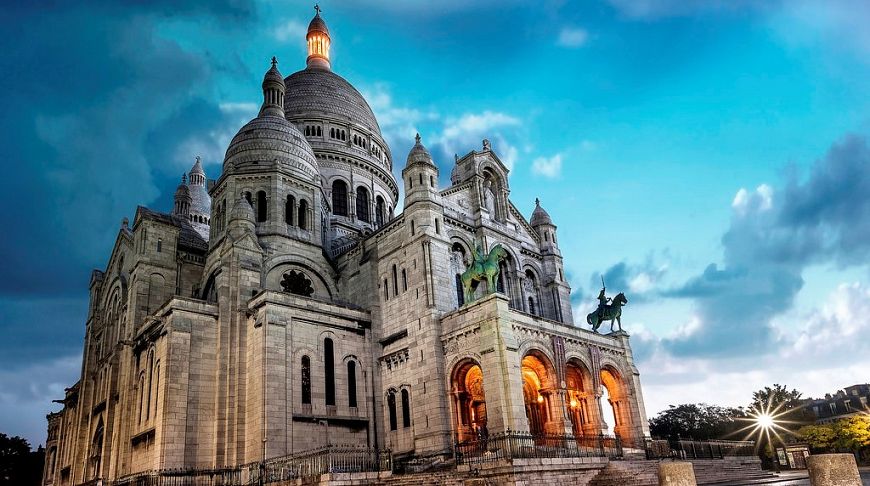The Basilica of Sacre-Coeur is a beautiful cathedral located at the summit of Montmartre, visible from any point in Paris on a clear day.
History of Construction

The decision to build the Basilica of Sacre-Coeur was made on September 4, 1870, the day the Third Republic was proclaimed. On that day, Bishop Fournier delivered a passionate speech stating that the French army’s defeat in the Franco-Prussian War was divine punishment for the “moral decline” following the French Revolution.
A society divided into devout Catholics and legitimate royalists on one side, and democrats, socialists, and radicals on the other, was punished. Although some sources claim the basilica was erected in honor of the fifty thousand fallen during the war, according to the National Assembly’s decree in 1873 (responding to the archbishop’s wish), the basilica was built to atone for the sins of the Paris Commune.
It was on Montmartre where the first uprising of the Paris Commune occurred, and where Archbishop Darboy, who became a martyr for the reborn Catholic Church, was executed. His successor claimed that in October 1872, he had a vision, and in the clouds scattered over Montmartre, he saw the truth: “Here, where the souls of martyrs are, here the Sacred Heart must reign, becoming a beacon for the suffering.”
With the resignation of Adolphe Thiers’ government in May 1873, Bishop François Pie expressed the national aspiration for spiritual renewal: “The hour of God has come,” for which the Sacre-Coeur Church is the main, material monument. Financing the future basilica was undertaken by all French parishes, and the construction took several decades (1875—1914).

The project’s architect was the talented creator Paul Abadie, who surpassed more than seventy-seven competitors. In 1880, there was an attempt to halt the construction when the basilica was called an “unceasing provocation to civil war.” The matter even reached the parliament, where the project was defended by the archbishop, despite Georges Clemenceau’s (the future Prime Minister) claim that the basilica was a material stigmatization of the revolution. Another attempt to stop the work was prevented in 1897, although by that time practically the entire interior was completed, and Sacre-Coeur had been functioning for nearly six years.
Abadie passed away in 1884, having only witnessed the foundation’s construction, and the work continued under five architects: Honoré Daumet (1884-1886), Jean-Charles Laisné (1886-1891), Henri-Pierre-Marie Rauline (1891-1904), Lucien Magne (1904-1916), and Jean-Louis Hulot (1916-1924). All major work was completed by 1914, but the war intervened, and the church was only consecrated in 1919.

The funds for the basilica, estimated at seven million French francs and entirely raised through donations, ran out before the visible above-ground part appeared. A temporary chapel was consecrated in March 1876, and pilgrim donations became the basis for the basilica’s budget. Anyone who donated could, for example, lay a commemorative brick.
English geographer and historian David Harvey noted that the echo of “martyrs” is still heard within the basilica’s walls. This idea is confirmed by the fact that in 1971, demonstrators pursued by the police found refuge in Sacre-Coeur, in the church “built on the bodies of communards.” This provocative statement was vividly illustrated in the leaflets they distributed.
Architecture

The Basilica of Sacre-Coeur is an extraordinary architectural structure. This massive building has managed to maintain its bright white color even in a noisy and sometimes dirty city like Paris. The secret lies in the travertine stone from the Château-Landon quarries, which turns white upon contact with rainwater.
Thus, the church illuminates the capital with its snow-white walls. The overall style is quite unusual—the holy temple is imbued with Roman-Byzantine features, contrasting sharply with the excesses of French Baroque in the decoration of the Garnier Palace.
Many design elements of the basilica symbolize nationalist motifs: in the gallery with three arches are bronze statues of Saint Joan of Arc and King Saint Louis IX, sculpted by Lefevre, and there is a nineteen-ton bell named “Savoyarde,” cast in Annecy and installed in honor of Savoy’s entry into France in 1860. The basilica complex includes a meditation garden with a fountain. The dome’s summit is open to tourists, offering an unforgettable view of Paris (entry to the top is paid).
Interior Decoration

Similar to the exterior, the basilica’s interior is decorated in the Roman-Byzantine style, giving the “House of God” an atmosphere of harmony and peace. The light and some decorative details focus attention on the semi-circular apse. The beautiful stained-glass windows were destroyed by the 1944 bombing and replaced in 1946. The interior also includes two significant elements that complete the magnificent ensemble: the mosaic and the grand organ.
The 475-square-meter mosaic depicting Jesus Christ is one of the largest in the world. Jesus is shown resurrected, clothed in white robes, with open arms, revealing His heart to the people. Surrounding Him are worshippers, including saints who protected France: the Virgin Mary, Saint Michael, Saint Joan of Arc, representing France, offering a crown, and Pope Leo XIII.
The grand pipe organ of the Basilica is unanimously considered one of the most stunning not only in Paris but throughout Europe. This instrument is the last work of the renowned master Aristide Cavaillé-Coll. Due to its impressive size and unique sound quality, the French government recognized the organ as a national monument in 1981.
Visiting Hours and Rules
The basilica is open daily from 6 AM to 11 PM. After 11 PM, only those registered for the night service can remain on the basilica’s premises.
As the Basilica of Sacre-Coeur is a Catholic church, several basic visiting rules apply:
- Filming (video and photo) inside the Basilica is prohibited. Filming outside is allowed (no prior permission from the administration is required). Photos for non-commercial use can be purchased on the basilica’s premises.
- Maintain silence on the basilica grounds, speak in whispers to avoid disturbing worshippers.
- To show respect for the church, entry in beachwear, excessively revealing, or provocative clothing is prohibited.
Location and How to Get There
Address: 35 Rue du Chevalier de la Barre, 75018 Paris, France
By metro:
- From Jules Joffrin station (Line 12) on Montmartre bus (Montmartrobus) — stop Place du Tertre
- From Pigalle station (Line 12 or Line 2) on Montmartre bus (Montmartrobus) — stop Norvins
- From Anvers station (Line 2) by cable car or on foot
- From Abbesses station by cable car or on foot
By bus:
- Buses 30, 31, 80, and 85 (stop Anvers Sacre-Coeur).

